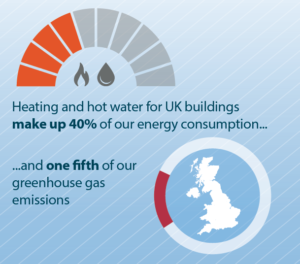 Heating and hot water within buildings is responsible for 40% of the UK’s energy consumption and 20% of its greenhouse gas emissions. The Heat Network Regulations 2014 aim to tackle this but lack of publicity and messy delivery mean that many commercial and domestic landlords are left either unaware that they need to comply or bewildered on how to do it. Carbon Smart director Louise Quarrell explains.
Heating and hot water within buildings is responsible for 40% of the UK’s energy consumption and 20% of its greenhouse gas emissions. The Heat Network Regulations 2014 aim to tackle this but lack of publicity and messy delivery mean that many commercial and domestic landlords are left either unaware that they need to comply or bewildered on how to do it. Carbon Smart director Louise Quarrell explains.
The Regulations affect all organisations that supply and charge for heat, cooling or hot water through a communal or district network, regardless of whether this is billed for directly or through a service charge. This includes landlords with multi-tenanted offices, housing providers, universities, local authorities, and residential care homes.
The Regulations have laudable aims – to drive carbon savings by motivating energy efficient behaviour through charging end-users for the heating and cooling they actually consume. While this is an admirable goal, has it been implemented and monitored effectively to achieve results?
The requirement to bill end users based on actual supply came into effect on 19 December 2014. Notifications by suppliers of heat and hot water through communal or district networks were due by 31 December 2015. The next step is to install heat meters for each end user in the building. However, haphazard roll out has left qualifying landlords either unaware or baffled by the requirements.
The Regulations have been poorly publicised. The Department for Business, Energy & Industrial Strategy (BEIS) state that they have, and continue to, exploit a range of awareness raising activities. Yet even now, almost a year after the notification deadline, we regularly come across organisations who are not aware that they need to comply.

Deadlines have been altered multiple times. The original notification deadline was April 2015; this was pushed back to December 2015. The deadline for installing meters has been moved from December 2016 yet the new date is unknown, although it’s likely to be in 2018 to allow organisations sufficient time to budget and plan the required work. Whilst BEIS are adamant that the deadline moves are aimed at making compliance easier, it does make it difficult for organisations caught by the regulations to keep track and plan their response accordingly.
Compliance documents have been released and then revoked. The Regulations require suppliers to install meters where technically and economically viable to do so. This requires a viability assessment to be carried out. However, the viability tool designed for this purpose was withdrawn many months ago and remains unavailable. This has left organisations unable to ascertain whether they need to comply with the meter installation requirement.
Complying with the regulations is not a straight-forward exercise. The information required within the compliance documents is often not readily available and needs to be sourced from technical specifications, O&M manuals, site visits or on-line research. Retro-fitting meters can be expensive and disruptive to tenants, and needs to be carefully managed. For larger organisations with multiple systems in scope, the compliance exercise can be a significant undertaking. All the more reason to want to get it right first time.
Mounting concerns have forced BEIS to re-think the Regulations and a consultation on the requirements is due early next year. However, the requirement to notify BEIS about the network and provide key information on the system remains as 31 December 2015. BEIS is starting to contact organisations and to chase up non-compliance. Therefore, if you are yet to comply with this element – your time is running out.
Although BEIS has stressed it will work with companies to help them comply with the regulations, breaches of the Regulations could be subject to compliance notices, penalties (£5,000 per offence) or even criminal prosecution.
It’s a shame the Regulations have suffered these set-backs, but from our conversations with the team at BEIS, they seem determined to build a smoother, more straight forward compliance process. Let’s hope they get the revised legislation right – focusing on the efficiency and carbon savings which were its principle aim.
Follow us at @EnergystMedia. For regular bulletins, sign up for the free newsletter.




I may be being cynical but I suspect it suits consultants and landlords to run the calculations and conclude it is not economical to install Heat Metering
Hi Steve, you may be right but landlords/consultants must retain evidence of how they have made such a judgement. Regulatory Delivery will be checking compliance and may ask to see such evidence. If it isn’t available, or is dubious, organisations could be fined and forced to comply.
The aim is always that the savings achieved exceed the cost of installing the meters.
Hi Louise
We came up with a 10 year Heat Metering As A Service offering on a Grade A multi let building for one of the largest Managing Agents that used the metrics required by the legislation and proved it was economically viable to undertake Heat Metering. They chose to ignore this and go with their consultant’s conclusion that it was not economically viable. Hence my cynicism.
You would have thought landlords would fall over themselves to install heat meters. If they set them up on the basis that the circuit contains water, they can add antifreeze “to protect the system from freezing” which will boost their revenue by maybe 10%, as it reduces the specific heat of the circulating medium, requiring proportionately higher flow to deliver the same quantity of heat. The regulations ignore the possibility of “wrong fluid” error in heat meters.